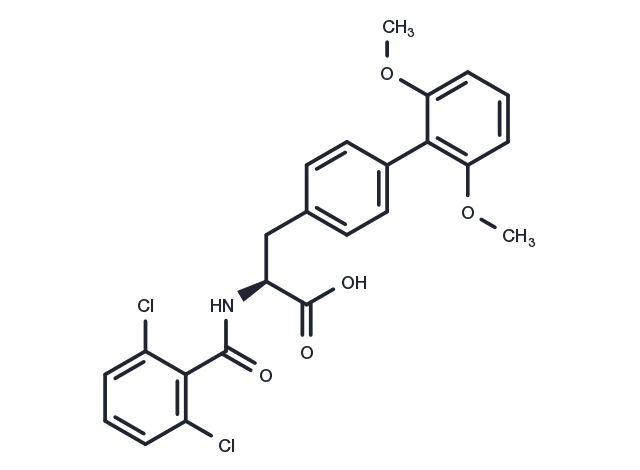Powder: -20°C for 3 years | In solvent: -80°C for 1 year


TR-14035 (MDK-1191) is a dual antagonist of α4β7/α4β1 integrins (IC50s: 7/87nM).

| Pack Size | Availability | Price/USD | Quantity |
|---|---|---|---|
| 1 mg | In stock | $ 81.00 | |
| 2 mg | In stock | $ 117.00 | |
| 5 mg | In stock | $ 178.00 | |
| 10 mg | In stock | $ 289.00 | |
| 25 mg | In stock | $ 522.00 | |
| 50 mg | In stock | $ 756.00 | |
| 100 mg | In stock | $ 1,060.00 | |
| 1 mL * 10 mM (in DMSO) | In stock | $ 189.00 |


| Description | TR-14035 (MDK-1191) is a dual antagonist of α4β7/α4β1 integrins (IC50s: 7/87nM). |
| Targets&IC50 | α4β7 integrin:7 nM, α4β1 integrin:87 nM |
| In vitro | TR-14035 (IC50: alpha(4)beta(7)/alpha(4)beta(1)=7/87 nM) has completed Phase I studies in Europe [1]. TR-14035 was taken up by rat and human hepatocytes by an apparently single saturable mechanism with K(m) of 6.7 and 2.1 microM, respectively, and taurocholate and digoxin reduced this uptake. OATP1B1/OATP-C and OATP1B3/OATP8 expressed in oocytes mediated the TR-14035 uptake with K(m) of 7.5 and 5.3 microM, respectively [2]. TR14035 blocked the binding of human alpha(4)beta(7) to a (125)I-MAdCAM-Ig fusion protein with IC(50) values of 0.75 nM. Under shear flow in vitro, TR14035 blocked binding of human alpha(4)beta(7)-expressing RPMI-8866 cells or murine mesenteric lymph node lymphocytes to MAdCAM-Ig with IC(50) values of 0.1 microM [3]. |
| In vivo | Biliary excretion and total body clearance of unchanged TR-14035 in EHBRs were significantly lower than those in normal rats, while there was no difference in the clearances between wild and mdr1a/b- or Bcrp-knockout mice [2]. TR14035 blocked adhesion to HEVs (ED50: of 0.01-0.1 mpk i.v.) [3]. |
| Cell Research | RPMI8866 cell line and Jurkat T lymphoblastoid cell line were grown as a suspension culture in RPMI 1640 media, 10% FCS, 2 mM glutamine, 100 units/mL penicillin G, 100 mg/mL streptomycin sulfate at 37 °C and 5% CO2. Adhesion assays have been detailed elsewhere. Microtiter plates were coated with 20 mg/mL HSA for 2 h at room temperature, washed once with PBS and derivatized with 10 mg/mL SPDP for 1 h. After washing, CS-1 (or sCS-1) derived peptide solution (100 mL at 100 μg/mL) was added to the wells and allowed to crosslink to the plates overnight at 4 °C. Non-reacted sites were blocked with 100 mL of 1% OV in PBS for 1 h at 37 °C. RPMI8866 cells were suspended in Dulbecco's modified Eagle's medium with 0.25% OV at a density of 2.5 ×106/mL and incubated for ~1 h at 37 °C with varying concentrations of antagonists on peptide-coated plates. Following washing (EL404 plate washer), bound cells were quantified by measuring endogenous N-acetyl-hexosaminidase activity by reading the optical density at 405 nm using the enzyme substrate p-nitrophenol-N-acetyl-b-d-glucoseaminide. IC50 values were generated by nonlinear regression from titration curves of antagonists from seven doses and reported as the average of a minimum of two experiments. Since experimental variability was noted with respect to the IC50 of the internal standard [(1S - cis) - N - [(3 - carboxy - 2,2,3 - trimethylcyclopentyl)- carbonyl]-O-[(2,6-dichlorophenyl)methyl]-l-tyrosine] a normalization procedure was done using the global mean value [IC50=0.224±0.17 μM (N=19)] of the internal standard. For the Jurkat cell adhesion assay, OV was replaced with 0.25% HSA for both blocking and adhesion buffers. Standard error of the mean for the Jurkat cell adhesion assay was typically <10% for each experiment and no normalization was needed [1]. |
| Animal Research | For biliary excretion studies in mice and rats, a cannula (polyethylene tube, SP8 for mice and SP10 for rats) was inserted into the bile duct of the anesthetized animal. In the rat, after complete recovery from diethyl ether anesthesia, TR-14035 was administered intravenously at a dose of 3 mg/ml/kg, and the bile, urine, and blood were collected at designated time intervals. In the mouse, TR-14035 was administered intravenously at a dose of 3 mg/4 ml/kg, and the bile and blood were collected at designated time intervals under pentobarbital anesthesia. Blood was centrifuged to separate plasma, and all the samples were stored at j20 -C until analysis by LC-MSD [2]. |
| Synonyms | MDK-1191 |
| Molecular Weight | 474.33 |
| Formula | C24H21Cl2NO5 |
| CAS No. | 232271-19-1 |
Powder: -20°C for 3 years | In solvent: -80°C for 1 year
H2O: Insoluble
DMSO: 40 mg/Ml (84.3 mM)
You can also refer to dose conversion for different animals. More
bottom
Please see Inhibitor Handling Instructions for more frequently ask questions. Topics include: how to prepare stock solutions, how to store products, and cautions on cell-based assays & animal experiments, etc.
TR-14035 232271-19-1 Cytoskeletal Signaling Integrin MDK1191 MDK-1191 autoimmune disease asthma inhibit MDK 1191 TR 14035 allergic TR14035 inflammation Inhibitor alpha(4) inhibitor
